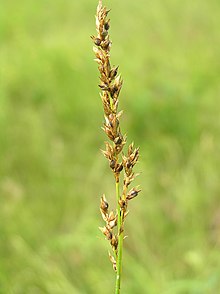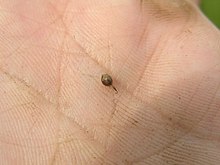Blackhead sedge
| Blackhead sedge | ||||||||||||
|---|---|---|---|---|---|---|---|---|---|---|---|---|

Blackhead sedge ( Carex appropinquata ) in the Botanical Garden Munich-Nymphenburg |
||||||||||||
| Systematics | ||||||||||||
|
||||||||||||
| Scientific name | ||||||||||||
| Carex appropinquata | ||||||||||||
| Schumach. |
The blackhead sedge ( Carex appropinquata ) is a species of the sourgrass family (Cyperaceae). A frequently used synonym is Carex paradoxa Willd. , from which the German names strange sedge and miracle sedge are derived. The species forms clumps with a black-brown fiber tuft of dissolved leaf sheaths at the base. The stalks reach heights of 30 to 80 centimeters and the inflorescences are spike-like panicles . The distribution area is in Central and Northern Europe and extends to Siberia. The black crested sedge is considered endangered in Austria and Germany. It provides litter, but is difficult to mow.
description
Appearance and leaf
The black-headed sedge is a perennial herbaceous plant that forms dense, bulky clumps . No runners are formed. At the base there is a black-brown, glossy tuft of fibers made up of dissolved leaf sheaths. The stalks stand upright and reach heights of 30 to 80 centimeters. They are thin and triangular and rough in the upper part. The leaf blades are flat, 2 to 3 millimeters wide, usually yellow-green, sometimes gray-green, not very stiff and cutting rough. They never rise above the inflorescence.
Inflorescence, flower and fruit
The strongly contracted, sparsely branched, grape-like, seldom also loose and flabby panicle inflorescences are 2 to 8, rarely up to 10 centimeters long with a diameter of 0.5 to 1.5 centimeters. The inflorescence branches are usually upright, and have spelzige, sometimes foliage leaf-like bracts . The lowest branch usually reaches a length of 1.5 to 2.5 centimeters. The spikelets are oval to cylindrical and 4 to 15 millimeters long. The female flowers are in the lower part, the male in the upper part of the spikelets. The husks are reddish brown, broadly oval, pointed and 3 millimeters long. The fruit sacs are dark brown, dull, clearly longitudinally veined, also 3 millimeters long, rounded egg-shaped, and suddenly merge into a beak. Two scars are formed. The flowering time is in May and June.
Chromosome number
The number of chromosomes is 2n = 64.
Similar species
The structure of the inflorescences lies roughly between that of the panicle sedge ( Carex paniculata ) and that of the wire sedge ( Carex diandra ), but the species can be easily distinguished from the other two by the tuft of fibers. The comb-sedge ( Carex disticha ), which is also similar, differs from the black-headed sedge in its runners.
Occurrence and endangerment
The Schwarzkopf Sedge is a Nordic-Eurasian floral element of the temperate and boreal zones. Its area extends in Europe north to 68 ° north latitude; in the south it occurs in northern Italy, Yugoslavia, Romania, southern Russia, Anatolia and in the Caucasus region; but otherwise it is absent in southern Europe for long stretches ; in the east, its area in Siberia extends into the Jennisei region and into the Altai Mountains. It grows in Central Europe scattered from the lowlands to altitudes of around 1500 meters in the Alpine region. In the Allgäu Alps in Bavaria, it rises between Kreuzeck and Kappelberg near Nesselwang to an altitude of 1350 meters. In the Central European lowlands, especially in the west there, it is rare; in the foothills of the Alps and in the Regen-Naab-Altmühl basin it occurs in a scattered manner. It is absent in the central and southern Alps. It is often a stock-building where it is found.
It grows in the outer bank of stagnant bodies of water, less often on rivers, it also colonizes flat bogs, open alluvial forests, wet meadows, swamps, ditches and forest ponds, mostly on alkaline or calcareous, mesotrophic swamp humus soils. It is a companion plant of the great sedge reed (Magnocaricion) and the alder break (Alnion). The blackhead sedge promotes siltation. The fruits contain a floating tissue and are thus also transported through the water.
The Schwarzkopf sedge is endangered in Austria and Germany. It loses in Central Europe through the use of the banks of lakes, z. B. increasingly locations through campsites. It has declined especially in the foothills of the Alps.
Systematics and research history
The blackhead sedge is assigned to the subgenus Vignea . The first description of Carex appropinquata was made in 1801 by Heinrich Christian Friedrich Schumacher . The generic name Carex comes from Latin and denotes grasses with cutting leaves. The specific epithet appropinquata also comes from Latin and means “crowded”. It refers to the strongly contracted panicle.
Synonyms for Carex appropinquata Schumach. are among others Carex paniculata var. paradoxa (Rchb.) Fiori , Carex paradoxa Willd. , Caricina paradoxa (Rchb.) St.-Lag. , Vignea appropinquata (Schumach.) Soják and Vignea paradoxa Rchb.
use
The blackhead sedge provides good litter , but is difficult to mow due to the dense clumpy growth.
swell
literature
- Dietmar Aichele, Heinz-Werner Schwegler, Mark Bachofer: Our grasses. Over 400 color drawings . Updated 12th edition. Franckh-Kosmos, Stuttgart 2011, ISBN 978-3-440-12573-1 , p. 166 .
- Manfred A. Fischer, Karl Oswald, Wolfgang Adler: Excursion flora for Austria, Liechtenstein and South Tyrol . 3rd, improved edition. Province of Upper Austria, Biology Center of the Upper Austrian State Museums, Linz 2008, ISBN 978-3-85474-187-9 , p. 1110, 1120 .
- Helmut Genaust: Etymological dictionary of botanical plant names. 3rd, completely revised and expanded edition. Nikol, Hamburg 2005, ISBN 3-937872-16-7 , p. 128 (reprint from 1996).
- Dietmar Aichele, Heinz-Werner Schwegler: The flowering plants of Central Europe . 2nd Edition. tape 5 : Swan flowers to duckweed plants . Franckh-Kosmos, Stuttgart 2000, ISBN 3-440-08048-X .
- Oskar Sebald, Siegmund Seybold, Georg Philippi, Arno Wörz (eds.): The fern and flowering plants of Baden-Württemberg . tape 8 : Special part (Spermatophyta, subclasses Commelinidae part 2, Arecidae, Liliidae part 2): Juncaceae to Orchidaceae . Eugen Ulmer, Stuttgart (Hohenheim) 1998, ISBN 3-8001-3359-8 .
Individual evidence
- ↑ a b c German name after Aichele, Schwegler: Our grasses , p. 166
- ↑ a b c d e f Dietmar Aichele, Heinz-Werner Schwegler: Our grasses , p. 166
- ↑ a b c Carex appropinquata Schumach. In: Info Flora , the national data and information center for Swiss flora . Retrieved August 16, 2013.
- ^ A b Fischer, Oswald, Adler: Excursion flora for Austria, Liechtenstein and South Tyrol , p. 1120
- ^ Carex appropinquata at Tropicos.org. In: IPCN Chromosome Reports . Missouri Botanical Garden, St. Louis
- ↑ Erhard Dörr, Wolfgang Lippert : Flora of the Allgäu and its surroundings. Volume 1 IHW-Verlag, Eching near Munich, 2001, ISBN 3-930167-50-6 , p. 248.
- ^ Erich Oberdorfer : Plant-sociological excursion flora for Germany and neighboring areas . With the collaboration of Angelika Schwabe and Theo Müller. 8th, heavily revised and expanded edition. Eugen Ulmer, Stuttgart (Hohenheim) 2001, ISBN 3-8001-3131-5 , pp. 174 .
- ^ Carex appropinquata Schumach., Blackhead sedge. In: FloraWeb.de.
- ^ Fischer, Oswald, Adler: Excursion flora for Austria, Liechtenstein and South Tyrol , p. 1110
- ^ Christian Friedrich Schumacher: Enumeratio plantarum in partibus Saellandiae Septentrionalis et Orientalis. Volume 1. Brummer, Hafniae 1801, p. 266 ( online ).
- ^ Carex appropinquata at Tropicos.org. Missouri Botanical Garden, St. Louis, accessed August 16, 2013.
- ↑ Exactly: Etymological Dictionary of Botanical Plant Names , p. 128
- ^ Carex appropinquata. In: The Plant List. Retrieved August 16, 2013 .
Web links
- Blackhead sedge . In: BiolFlor, the database of biological-ecological characteristics of the flora of Germany.
- Profile and distribution map for Bavaria . In: Botanical Information Hub of Bavaria .
- Carex appropinquata Schumach. In: Info Flora , the national data and information center for Swiss flora .
- Distribution in the northern hemisphere from: Eric Hultén, Magnus Fries: Atlas of North European vascular plants. 1986, ISBN 3-87429-263-0 at Den virtuella floran. (swed.)
- Thomas Meyer: Data sheet with identification key and photos at Flora-de: Flora von Deutschland (old name of the website: Flowers in Swabia ).
- Data sheet at the flora of Upper Franconia .
- Data sheet from Schede di Botanica - Flora Italiana .


